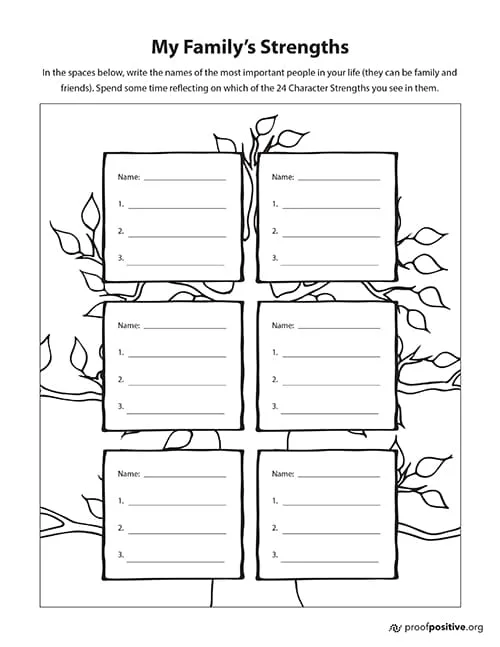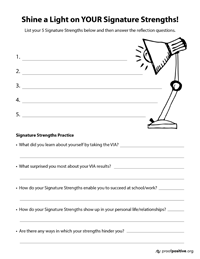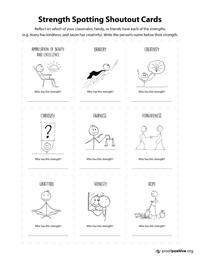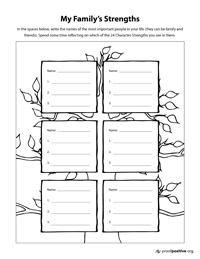TEACH Strength Spotting
Explore the intersection of positive psychology and autism intervention by teaching your students how to notice and name each other’s strengths.
Start Teaching!
This comprehensive bundle comes with everything you need to bring Strength Spotting into the classroom, from teaching slides and notes to supplementary resources.
Quick Link Library
Shine a Light on YOUR Signature Strengths!
10 Minutes
10 Minutes
Strength Spotting in Hindsight
15 Minutes
Strength Spotting Shout Out Cards
10-15 Minutes
15-20 Minutes
Behavioral Intervention Plan Recommendations
15 Minutes
15 Minutes
Integration into Curriculum Instructions
15 Minutes
Expanded Teaching Resources
Lesson Plans & Teaching Materials
- Objectives (PDF)
- Teaching Slides — All Activities (Google Slides)
- Teacher’s Guide (Google Slides, PDF)
- Teacher Answer Key (PDF)
- Unit Study Bundle Pack — All Activities (PDF)
Behavior Intervention Plans (BIPs) are more than just behavior supports – they’re pathways to learning and success. By prioritizing wellbeing and happiness in BIPs, you can help create structure and consistency while also making space for joy, connection and resilience. With the right supports in place, students can feel empowered, successful and experience more happiness at school.
- Include the student’s Signature Strengths, with the most common ways they display that strength in action, as a section of your BIP template.Examples:Zest: “Student X is highly enthusiastic and energetic. This strength can be seen in the speed with which to do things, their willingness to run errands for the teacher and their excitement during body/brain breaks.”
Humor: “Student X is extremely funny and playful. This strength can be seen in the way they are quick to laugh when the teacher makes a joke, their ability to draw attention to themselves and make others laugh, and their authentic joy in playing games in the classroom.” - Ensure the student’s signature strengths are posted and present in their visual field during all classroom activities. This can include their desk, the wall/board in front of them, or included with another tracker they regularly use. Engage in Strength Spotting when the student independently utilizes a signature strength.
- Ensure the student’s signature strengths are posted and present on all data collection forms. Include a space for the person collecting behavioral data to include strengths they spotted across the session or day.
- Develop a plan for the target behavior of increasing the number of times (frequency) a student independently and effectively uses a Signature Strength over a specified amount of time. Effectiveness, or quality, should be objectively defined for/with the student. Collect data on frequency and graph as you would a challenging behavior.
Individualized Education Plans (IEPs) ensure every student has access to the supports they need to thrive. When happiness and wellbeing is included and prioritized in IEPs, students are more likely to flourish in learning and in life. By shifting from a deficit-based approach to one of strengths and potential, IEPs can open doors to learning, connection and joy – at school and beyond.
- When students are preparing for their upcoming IEP meeting, have them reflect on their Signature Strengths and generate an introductory presentation about their Signature Strengths and all the ways they have been spotting them over the year. This presentation can be in the form of slides, a one-page overview, a poster with pictures, etc.
- Ensure that every IEP includes at least one goal that is related to the student’s Signature Strengths.
Examples
-
- The student will independently complete written and photographic entries into a gratitude journal on his iPad, using the “Happy App” with 90% accuracy on four out of five opportunities.
- The student will deploy her love of learning strength, by learning to use Pinterest to independently select art projects, recipes, or science experiments that she finds curious and interesting with 90% accuracy on three consecutive opportunities. She will be provided with weekly opportunities to express her creativity by completing those projects with teacher support.
- The student will use his creativity and leadership strengths to design and learn how to independently guide a series of 15-20 “energy breaks” for his peers. He will be given weekly opportunities to demonstrate his strength by independently leading his peers in high energy / fun breaks, when requested by the teacher.
- The student will enhance her hope/optimism, by learning and applying Goal Setting Theory (i.e., what goals are, why they are important, how to set goals, how to track progress and how to modify goals) and then writing three long-term goals (i.e., IEP goals) and chunking them into short-term goals (i.e., weekly goals).
Bringing wellbeing to the forefront doesn’t require a complete overhaul of your classroom routine. By integrating happiness skills into what you’re already teaching, you can help students learn and practice happiness in simple, meaningful ways. From morning meetings and check-ins to reading, writing, and relationship-building, there are countless ways to make wellbeing part of everyday learning.
- Incorporate Strength Spotting into transitions in and out of the classroom (e.g., have students sign in with their name and a signature strength they have used that day or when signing out to use the restroom, have students include a strength they will use to transition independently).
- Encourage teachers and/or paraprofessionals to leave “Strength Spotting Shoutouts” on a student’s desk when they are out of the room. Create a space in the classroom to post the shoutouts.
- If your student has a school/home communication log, include a space for the inclusion of Strength Spotting. Encourage parents/guardians to communicate about strengths they are seeing at home.
Classroom Activities
Each activity includes teacher notes and differentiated instruction across skill levels
- Activity 1: Identification of Signature Strengths
30-45 Minutes / Google Slides + Teacher Notes / Student Worksheets (PDF) - Activity 2: Strength Spotting Across the Day
20-30 Minutes / Google Slides + Teacher Notes / Student Worksheets (PDF) - Activity 3: Strength Spotting in Familiar People/Characters
20-30 Minutes / Google Slides + Teacher Notes - Activity 4: Strength Spotting in Our Classroom
20-30 Minutes / Google Slides + Teacher Notes / Student Worksheets (PDF) - Activity 5: Strength Spotting Family Tree
30-45 Minutes / Google Slides + Teacher Notes / Student Worksheets (PDF) - Activity 6: Strength Spotting Day-to-Day Reflection
10 Minutes / Google Slides + Teacher Notes / Student Worksheets (PDF) - Unit Study Bundle Pack — All Activities (PDF)












